Sivantos WL003BTE BTE Hearing Aid User Manual English
Sivantos GmbH BTE Hearing Aid English
Sivantos >
Contents
- 1. User Manual English
- 2. Installation Instructions
User Manual English
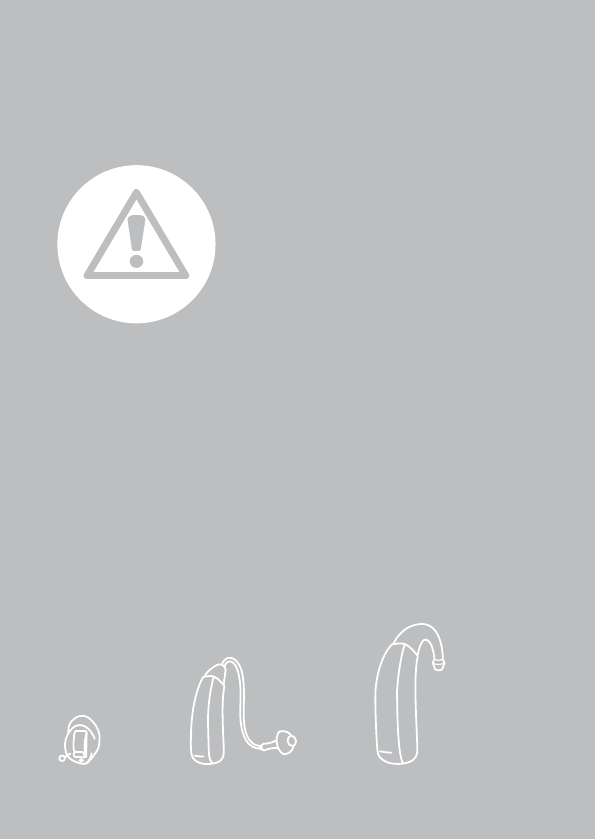
Safety manual
for hearing instruments
2Content
Content
Safety information 3
Intended use 3
Explanation of symbols 3
General warnings 4
BTE or RIC or custom models 11
For infants, small children and mentally
disabled persons 13
When using remote control apps 15
For Hearing Care Professionals 16
Important information 17
Transport and storage conditions 17
Disposal information 17
Conformance information 17
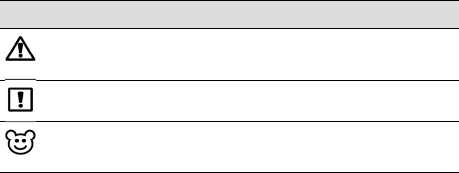
Safety information 3
This safety manual provides safety information and other
important information about your hearing instruments.
It covers several instrument types and optional features.
XRefer to the user guide of your hearing instruments, to
check the instrument type and the activated features.
Intended use
Hearing instruments are intended to improve the hearing
of hearing impaired persons. Diagnosis and prescription
of a hearing instrument must be performed by hearing
health specialists, e.g. acousticians, audiologists or
ENT doctors.
Use the hearing instruments and accessories only as
described in the respective user guides.
Explanation of symbols
Symbols used in this document
Points out a situation that could lead to serious,
moderate, or minor injuries.
Indicates possible property damage.
Information and warnings for children with
hearing instruments.
Safety information
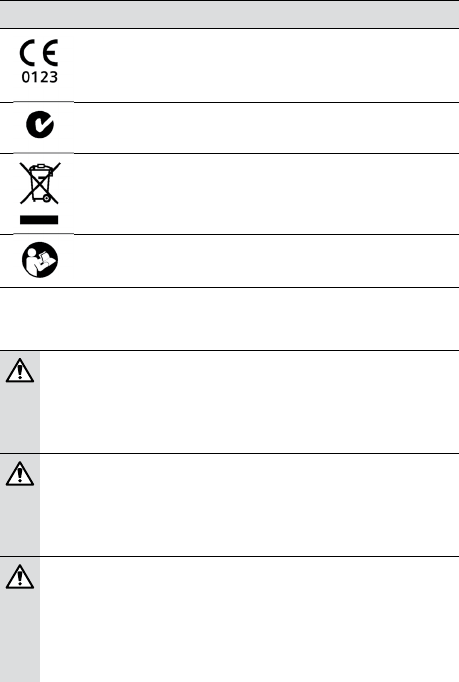
Safety information4
Symbols on the device or packaging
CE compliance label, conrms compliance with
certain European Directives, refer to section
"Conformance information".
EMC and radio communications compliance
label Australia.
Do not dispose of the device with general
domestic waste. Read more in section
"Disposal information".
Read and follow the instructions in the
user guide.
General warnings
WARNING
Risk of impairing the residual hearing of the user.
XUse only hearing instruments that have been
tted especially for your needs.
WARNING
Risk of injury!
XDo not use obviously damaged devices and
return them to point of sale.
WARNING
Note that any unauthorized changes to the product
may cause damage to the product or cause injury.
XUse only approved parts and accessories.
Ask your Hearing Care Professional for support.
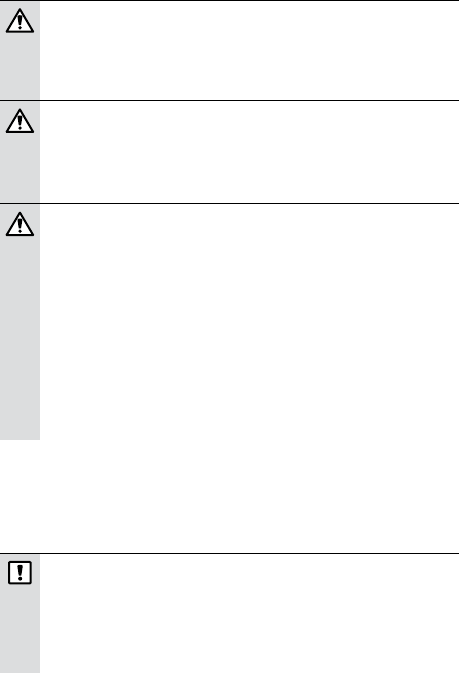
Safety information 5
WARNING
Your hearing instruments may reduce certain
background sounds, potentially also trafc or
warning signals.
WARNING
Risk of explosion!
XDo not use your hearing instruments in
explosive atmospheres (e. g. in mining areas).
WARNING
Choking hazard!
Your hearing instruments contain small parts
which can be swallowed.
XKeep hearing instruments, batteries and
accessories out of reach of children and
mentally disabled persons.
XIf parts have been swallowed consult a
physician or hospital immediately.
If you have hearing instruments that are intended for
the tting of infants, small children, or mentally disabled
persons, refer also to section "For infants, small children
and mentally disabled persons".
NOTICE
XProtect your hearing instruments from high
humidity. Do not wear them in the shower or
when you apply make-up, perfume, aftershave,
hairspray or suntan lotion.
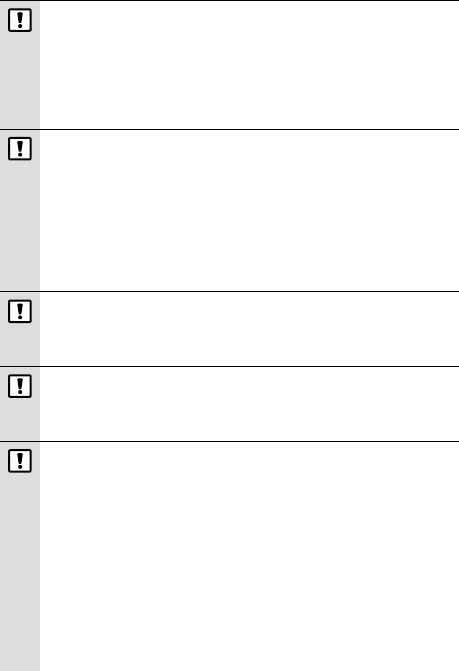
Safety information6
NOTICE
Only use zinc-air batteries or nickel-metal hydride
(NiMH) rechargeable batteries.
Do not use e.g. silver-zinc or lithium-ion
rechargeable batteries.
NOTICE
Leaking batteries damage the hearing instruments.
XTurn the hearing instruments off when not
in use to preserve the battery.
XRemove batteries when the instruments are not
in use for a prolonged period of time.
NOTICE
XProtect your hearing instruments from extreme
heat. Do not expose them to direct sunlight.
NOTICE
XDo not dry your hearing instruments in the
microwave oven.
NOTICE
Different types of strong radiation, e. g. during
X-ray or MRI head examinations, may damage
hearing instruments.
XDo not wear the hearing instruments during
these or similar procedures.
Weaker radiation, e. g. from radio equipment or
airport security, does not damage the hearing
instruments.
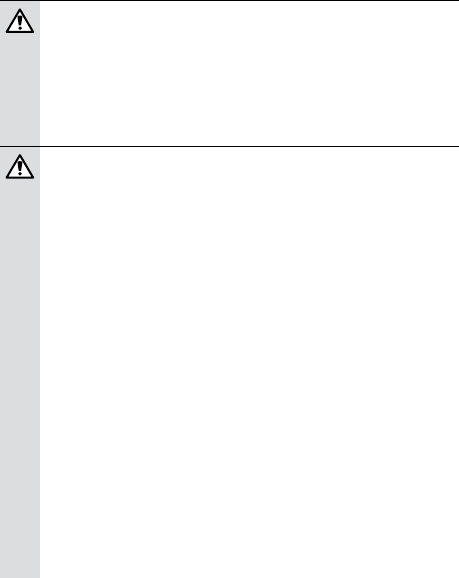
Safety information 7
Contraindications
WARNING
Consult a Hearing Care Professional if you
experience any unusual side effects like skin
irritation, excessive accumulation of ear wax,
dizziness, change in your hearing, or if you think
there may be a foreign object in your ear canal.
WARNING
A Hearing Care Professional should advise a
prospective hearing instrument user to consult
a licensed physician before using the hearing
instrument if the Hearing Care Professional
determines that the prospective user has any
of the following conditions:
XVisible congenital or traumatic deformity
of the ear.
XHistory of active drainage from the ear within
the previous 90 days.
XHistory of sudden or rapidly progressive
hearing loss within the previous 90 days.
XAcute or chronic dizziness.
XUnilateral hearing loss of sudden or recent
onset within the previous 90 days.
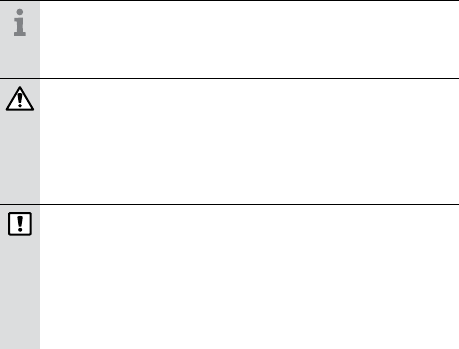
Safety information8
For hearing instruments with wireless functionality
In some countries restrictions for the usage of
wireless equipment exist.
XRefer to local authorities for further information.
WARNING
Risk of affecting electronic equipment!
XIn areas where the use of electronics or wireless
devices are restricted, verify if your device has
to be turned off.
NOTICE
Your hearing instruments are designed to comply
with international standards on electromagnetic
compatibility but interference with nearby
electronic devices could occur. In this case,
move away from the source of interference.

Safety information 9
For hearing instruments with tinnitus noiser function
Your hearing instrument may be equipped with a tinnitus
noiser. The use of the tinnitus noiser should be only on
the advice and in consultation with your Hearing Care
Professional.
WARNING
Risk of further impairment to the user’s hearing
health.
The volume of the tinnitus noiser can be set to
a level which could lead to permanent hearing
damage when used for a prolonged period of time.
XThe tinnitus noiser should never be used at
uncomfortable levels.

Safety information10
For hearing instruments with AutoPhone magnet
WARNING
Risk of affecting life support systems!
XUse a magnet only when it is a safe distance
away from life support systems, such as
pacemakers or magnetic valves. For example,
the safe distance between pacemaker and
magnet should be at least 10 cm (4 inches).
NOTICE
Magnets can disturb electrical devices and delete
stored data.
XKeep magnets away from computers, monitors,
television sets, storage media and other
electronic equipment/devices.

Safety information 11
For hearing instruments with a magnet in the battery
compartment
WARNING
Risk of interference with active and non-active
implants!
If you wear an active or a non-active implant,
e.g. a brain implant:
XPrior to use, have the electromagnetic
compatibility veried.
Consult the physician that implanted the device
before using your hearing instruments.
XKeep a safe distance of about 1.6 inches (4 cm)
between the implant and hearing instruments.
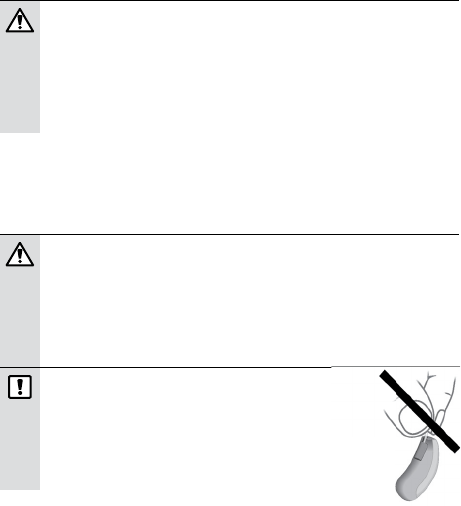
Safety information12
BTE or RIC or custom models
BTE models
Instruments that are worn behind the ear and that have
a tube.
CAUTION
Risk of injury!
XAlways wear the tube with an ear piece.
XMake sure that the ear piece is completely
attached.
RIC models
The receiver is placed within the ear canal and connected
to the instrument via a receiver cable.
CAUTION
Risk of injury!
XAlways wear the receiver cable with an ear piece.
XMake sure that the ear piece is completely
attached.
NOTICE
XDo not pull the receiver
connection as this could damage
your hearing instruments.
Custom models
There is no additional safety information that applies for
custom models only.

Safety information 13
For infants, small children and mentally
disabled persons
There are special hearing instruments for the tting
of infants and small children. Ask your Hearing Care
Professional for further information.
WARNING
Choking hazard!
Your hearing instruments contain small parts which
can be swallowed.
XEnsure adequate supervision if infants, small
children or mentally disabled persons need to
wear hearing instruments.
XCheck the completeness of the hearing
instruments regularly.
XEnsure that your child or the mentally disabled
person does not detach the hearing instrument
from the earmold.
XConsult your Hearing Care Professional if the
housing is deformed.
XKeep the battery compartment locked. Verify the
proper function of the locking mechanism.
XKeep batteries and accessories out of children's
or mentally disabled person's reach.
XIf swallowed consult a physician or a hospital
immediately.

Safety information14
When using remote control apps
When using an app for controlling hearing instruments:
WARNING
Risk of hearing damage!
The device with the app for controlling hearing
instruments generates short control signals which
may be audible. If the device running the app has a
very high audio output there is the risk of hearing
damage.
While using the app:
XDo not hold the loudspeaker of the device to
your ears or the ears of others.
XDo not use the device with headphones,
headsets or other audio playback devices.

Safety information 15
For Hearing Care Professionals
Tinnitus noiser function
The target population is primarily the adult population
over 21 years of age. The patient may have some control
of the level or volume of the signal and the patient should
discuss this adjustment as well as his or her comfort
level and sound of the signal with their Hearing Care
Professional.
WARNING
Risk of further impairment to the user’s hearing
health.
The volume of the tinnitus noiser can be set to
a level which could lead to permanent hearing
damage when used for a prolonged period of time.
XShould the tinnitus noiser be set to such a level
in the hearing instrument, advise the user of
the maximum amount of time per day he or she
should use the tinnitus noiser.
For example, occupational safety guidelines
restrict continuous noise exposure of 80 dBA SPL
to 8 hours per day.
XThe tinnitus noiser should never be used at
uncomfortable levels.

Important information16
Transport and storage conditions
During extended periods of transport and storage, please
observe the following conditions:
Storage Transport
Temperature 10 to 40 °C
(50 to 104 °F)
-20 to 60 °C
(-4 to 140 °F)
Relative humidity 10 to 80 % 5 to 90 %
For other parts, such as batteries, other conditions may
apply.
Disposal information
XRecycle hearing instruments, accessories and
packaging according to local regulations.
XTo avoid environmental pollution, do not throw
batteries into household trash.
XRecycle or dispose of batteries according to local
regulations or return them to your Hearing Care
Professional.
Important information
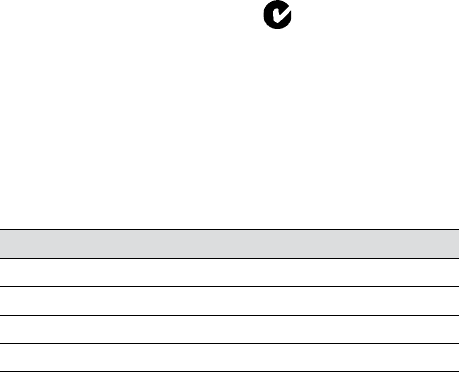
Important information 17
Conformance information
Europe: With the CE marking Siemens conrms
compliance with the European Directive 93/42/EEC
concerning medical devices.
Australia: Supplier code number N14203
Wireless functionality
Europe: For the products with wireless functionality
Siemens conrms compliance with the European
Directive 99/5/EC (R&TTE)concerning radio and
telecommunications terminal equipment.
USA and Canada
Technical details
Operating frequency: fc = 3.28 MHz
USA FCC ID: SGI-WL003BTE
Canada IC: 267AB-WL003BTE
Wireless platform model: e2e 3.0
This Class B digital apparatus complies with Canadian
ICES-003.
Changes or modications made to this equipment not
expressly approved by the legal manufacturer may void
the FCC authorization to operate this equipment.
This device complies with Part 15 of the FCC Rules and
with RSS-210 of Industry Canada.
Important information18
Operation is subject to the following conditions:
■this device may not cause harmful interference, and
■this device must accept any interference received,
including interference that may cause undesired
operation.
This equipment has been tested and found to comply
with the limits for a Class B digital device, pursuant
to Part 15 of the FCC Rules. These limits are designed
to provide reasonable protection against harmful
interference in a residential installation. This equipment
generates, uses and can radiate radio frequency energy
and, if not installed and used in accordance with the
instructions, may cause harmful interference to radio
communications. However, there is no guarantee that
interference will not occur in a particular installation.
If this equipment does cause harmful interference to
radio or television reception, which can be determined by
turning the equipment off and on, the user is encouraged
to try to correct the interference by one or more of the
following measures:
■Reorient or relocate the receiving antenna.
■Increase the separation between the equipment and
receiver.
■Connect the equipment to an outlet on a circuit
different from that to which the receiver is connected.
■Consult the dealer or an experienced radio/TV
technician for help.
www.siemens.com /hearing
Document No. A91SAT-02379-99T01-7600 EN
Order/Item No. 108 268 32 | Master Rev01, 06.2014
© Siemens AG, 07.2014
Legal Manufacturer
Siemens Audiologische Technik GmbH
Gebbertstrasse 125
91058 Erlangen
Germany
Phone +49 9131 308 0